My garden is for the birds!
There are so many benefits to a well-designed landscape garden…beauty, comfort, enjoyment, value, experience! How about the benefit of attracting beautiful songbirds to your home environment? Just include some plants that will provide food or shelter for these wonderful visitors. T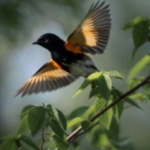 hen sit back and enjoy their soothing songs and brilliant hues. A book about birds of Ohio and a pair of binoculars might also be helpful. This is a great, educational activity for young and old alike. You might like to keep a journal of what you see. Of course trips to a local park might be fun also to widen your “collection”.
hen sit back and enjoy their soothing songs and brilliant hues. A book about birds of Ohio and a pair of binoculars might also be helpful. This is a great, educational activity for young and old alike. You might like to keep a journal of what you see. Of course trips to a local park might be fun also to widen your “collection”.
Some cool feathered friends to watch for in Central Ohio might include the American Redstart. Favorite foods include insects, Serviceberry, and Magnolia fruits. These cuties fly to Central America and the Caribbean in winter. Pictured is a female
 Cedar Waxwings might be confused with a female cardinal. But they have a glossy sheen to their coat. These ha
Cedar Waxwings might be confused with a female cardinal. But they have a glossy sheen to their coat. These ha rdy guys might stay in our area year ‘round given sufficient food and shelter. They enjoy several fruits including serviceberry, dogwood, juniper, and hawthorne. In winter, watch for them feeding on the waxy fruits of Bayberry! (not barberry!)
rdy guys might stay in our area year ‘round given sufficient food and shelter. They enjoy several fruits including serviceberry, dogwood, juniper, and hawthorne. In winter, watch for them feeding on the waxy fruits of Bayberry! (not barberry!)
A local favorite, the Bluebird is a treat to see! These guys prefer open spaces where they dart around feeding on insects. A nesting box might be helpful to attract bluebirds.
 The Goldfinch looks like a tropical little guy that escaped from a birdcage. I’ve seen these gathering by the hundreds around a favorite feeder! They prefer niger seed, the catkins of birch and alder, and many other weed seeds.
The Goldfinch looks like a tropical little guy that escaped from a birdcage. I’ve seen these gathering by the hundreds around a favorite feeder! They prefer niger seed, the catkins of birch and alder, and many other weed seeds.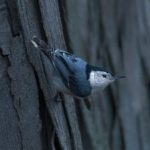
Another tough little winter visitor is the White Breasted Nuthatch. This fellow might be seen moving upside-down along the bark of large trees looking for insects and seeds.
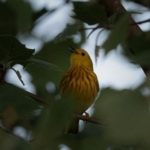 The Yellow Warbler is a brief visitor staying in Ohio only in late spring and early summer. They are primarily insectivores but will occasionally feed on small juicy fruits.
The Yellow Warbler is a brief visitor staying in Ohio only in late spring and early summer. They are primarily insectivores but will occasionally feed on small juicy fruits.
If you are not particularly a fan of mosquitos you might enjoy having Martins and Barn Swallows around. These two are  often confused. Purple Martins are the largest type of swallow. They are high flying insectivores, often attracted by the large structures of clustered little white houses on poles constructed and maintained by devotees.
often confused. Purple Martins are the largest type of swallow. They are high flying insectivores, often attracted by the large structures of clustered little white houses on poles constructed and maintained by devotees.
 Barn Swallows, on the other hand, are more common, a bit smaller, and fly lower. They can often be seen darting around mowers catching the disturbed insects.
Barn Swallows, on the other hand, are more common, a bit smaller, and fly lower. They can often be seen darting around mowers catching the disturbed insects.
One of the most interesting local birds is the hummers! These little guys usually prefer tubular flowers but will visit any nectar-producing flower and can easily be attracted to sugar solution in a feeder. Pictured here is a Rufous Hummingbird on a 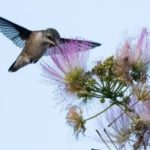 mimosa tree in my garden.
mimosa tree in my garden.
Some common landscape plants that are beneficial for attracting songbirds include Aronia (chokeberry), Amelanchier (serviceberry), Myrica (bayberry), Viburnum (all species), dogwood, crabapple, hawthorne, Cotoneaster, Juniper, ornamental grass, black-eyed susan, purple coneflower. Pretty much anything that produces seed or small decorative fruits will attract something.
It is also helpful to provide a water source. Feeders will also increase the number and variety of feathered visitors. (Guards will help prevent furry visitors to your feeder). Of course, this article only scratches the surface of the wide wonderful world of Ohio songbirds. But, hopefully, it might whet your appetite for further exploration!
- Thanks to my son-in-law, Aaron Shetler, for most of these pictures!

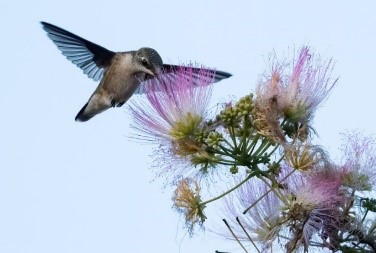
Comments are closed.